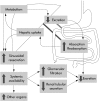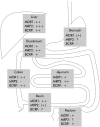ABC of oral bioavailability: transporters as gatekeepers in the gut
- PMID: 14633964
- PMCID: PMC1773875
- DOI: 10.1136/gut.52.12.1788
ABC of oral bioavailability: transporters as gatekeepers in the gut
Abstract
MDR1 (ABCB1), MRP2 (ABCC2), and BCRP (ABCG2) are members of the family of ATP binding cassette (ABC) transporters. These are plasma membrane transporters that are expressed in various organs. The role of MDR1 and MRP2 in the hepatobiliary system is well defined; both contribute to bile formation by transport of drugs, toxins, and waste products across the canalicular membrane. As they transport exogenous and endogenous substances, they reduce the body load of potentially harmful compounds. The role of ABCG2, which is also expressed in the canalicular membrane of hepatocytes, has not yet been fully characterised. All three proteins are also expressed in the apical membrane of enterocytes where they probably control oral availability of many substances. This important "gatekeeper" function of ABC transporters has been recognised recently and is currently under further investigation. Expression and activity of these transporters in the gut may differ between individuals, due to genetic polymorphisms or pathological conditions. This will lead to individual differences in bioavailability of different drugs, toxins, and (food derived) carcinogens. Recent information on substrates, transport mechanisms, function, and regulation of expression of MDR1, MRP2, and BCRP in different species is summarised in this review.
Figures




Similar articles
-
Novel understanding of ABC transporters ABCB1/MDR/P-glycoprotein, ABCC2/MRP2, and ABCG2/BCRP in colorectal pathophysiology.World J Gastroenterol. 2015 Nov 7;21(41):11862-76. doi: 10.3748/wjg.v21.i41.11862. World J Gastroenterol. 2015. PMID: 26557010 Free PMC article.
-
Structure, function, expression, genomic organization, and single nucleotide polymorphisms of human ABCB1 (MDR1), ABCC (MRP), and ABCG2 (BCRP) efflux transporters.Int J Toxicol. 2006 Jul-Aug;25(4):231-59. doi: 10.1080/10915810600746023. Int J Toxicol. 2006. PMID: 16815813 Review.
-
Efflux transporters in ulcerative colitis: decreased expression of BCRP (ABCG2) and Pgp (ABCB1).Inflamm Bowel Dis. 2007 Mar;13(3):291-7. doi: 10.1002/ibd.20030. Inflamm Bowel Dis. 2007. PMID: 17206689
-
Polymorphisms of the drug transporters ABCB1, ABCG2, ABCC2 and ABCC3 and their impact on drug bioavailability and clinical relevance.Expert Opin Drug Metab Toxicol. 2014 Oct;10(10):1337-54. doi: 10.1517/17425255.2014.952630. Epub 2014 Aug 27. Expert Opin Drug Metab Toxicol. 2014. PMID: 25162314 Review.
-
Intracellular trafficking and regulation of canalicular ATP-binding cassette transporters.Semin Liver Dis. 2000;20(3):339-51. doi: 10.1055/s-2000-9388. Semin Liver Dis. 2000. PMID: 11076400 Review.
Cited by
-
The Effects of Pharmaceutical Excipients on Gastrointestinal Tract Metabolic Enzymes and Transporters-an Update.AAPS J. 2016 Jul;18(4):830-43. doi: 10.1208/s12248-016-9928-8. Epub 2016 May 16. AAPS J. 2016. PMID: 27184579
-
Efflux transporters as a novel herbivore countermechanism to plant chemical defenses.J Chem Ecol. 2006 Jun;32(6):1181-96. doi: 10.1007/s10886-006-9079-y. Epub 2006 May 23. J Chem Ecol. 2006. PMID: 16770712 Review.
-
Resveratrol and Its Human Metabolites-Effects on Metabolic Health and Obesity.Nutrients. 2019 Jan 11;11(1):143. doi: 10.3390/nu11010143. Nutrients. 2019. PMID: 30641865 Free PMC article. Review.
-
An update on extra-oral bitter taste receptors.J Transl Med. 2021 Oct 21;19(1):440. doi: 10.1186/s12967-021-03067-y. J Transl Med. 2021. PMID: 34674725 Free PMC article. Review.
-
Drug Screening, Oral Bioavailability and Regulatory Aspects: A Need for Human Organoids.Pharmaceutics. 2021 Aug 17;13(8):1280. doi: 10.3390/pharmaceutics13081280. Pharmaceutics. 2021. PMID: 34452240 Free PMC article. Review.
References
-
- Tukey RH, Strassburg CP. Human UDP-glucuronosyltransferases: metabolism, expression, and disease. Annu Rev Pharmacol Toxicol 2000;40:581–616. - PubMed
-
- Ishikawa T. The ATP-dependent glutathione S-conjugate export pump. Trends Biochem Sci 1992;17:463–8. - PubMed
-
- Schinkel AH, Borst P. Multidrug resistance mediated by P-glycoproteins. Semin Cancer Biol 1991;2:213–26. - PubMed
Publication types
MeSH terms
Substances
LinkOut - more resources
Full Text Sources
Other Literature Sources
Research Materials
